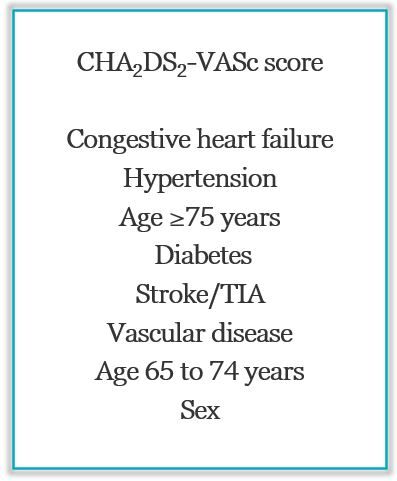- Clinical Technology
- Adult Immunization
- Hepatology
- Pediatric Immunization
- Screening
- Psychiatry
- Allergy
- Women's Health
- Cardiology
- Pediatrics
- Dermatology
- Endocrinology
- Pain Management
- Gastroenterology
- Infectious Disease
- Obesity Medicine
- Rheumatology
- Nephrology
- Neurology
- Pulmonology
Black Patients with Afib Significantly Less Likely to Receive Oral Anticoagulation at Hospital Discharge
Black patients hospitalized for atrial fibrillation (AF) were found significantly less likely than non-Hispanic White patients to be prescribed oral anticoagulation (OAC) therapy at discharge, according to results of a large restrospective cohort study. Moreover, at 1 year following discharge, Black patients with AF were at much greater risk of stroke, bleeding, and mortality.
The findings come from analysis of data from the American Heart Association’s Get with the Guidelines-Atrial Fibrillation (GWTG-AFIB) Registry, a national quality improvement initiative for patients hospitalized with AF.
Led by Jonathan Piccini, MD, MHS, of the Duke Clinical Research Institute, Duke University Medical Center, Durham, NC, the analysis revealed specifically that Black patients with AF are 25% less likely to be discharged on oral anticoagulation and when they are, 27% less likely to receive a newer direct oral anticoagulant (DOAC). One year later, Piccini et al found the risk of stroke among Black patients was 2 times greater than among White patients and the risk of mortality 1.2 times higher.
One year later, Piccini et al found the risk of stroke among Black patients was 2 times greater than among White patients and the risk of mortality 1.2 times higher.
As context for their analysis the researchers cite persistent OAC underprescribing among individuals with AF in racial and ethnic minority populations. Their interest was in better understanding the impact of these prescribing inequities on AF outcomes.
The researchers tapped the GWTG-AFIB Registry for the retrospective analysis, using data collected between 2014 and 2020 related to demographics, medical history, and clinical characteristics of people with AF. The primary outcome of interest was prescription of a DOAC or warfarin at hospital discharge; secondary outcomes included cumulative 1-year incidence of ischemic stroke, major bleeding, and mortality postdischarge. All outcomes were adjusted for patient demographic, clinical, and socioeconomic characteristics as well as hospital factors.

FINDINGS
Piccini and colleagues retrieved data for 69 553 patients from the 159 participating sites. Mean age among participants was 72 years and 49.1% were women. The median CHA2DS2-VASc bleeding risk score was 4. Racial and ethnic composition of the cohort was:
- 85.6% (n=59 570) non-Hispanic White
- 5.8% (n=4058) Hispanic
- 7.3% (n=5062) Black
- 1.2% (n=863) Asian
Overall, 81.1% of patients were prescribed OAC therapy at discharge, with 74.1% receiving a DOAC.
At hospital discharge, Piccini et al found OAC prescription was lowest among Hispanic patients (74.2%), followed by Black (77.7%), Asian (80.1%), and White patients (81.8%). In adjusted analyses, Black patients with AF were less likely than White patients to be discharged while taking any OAC (aOR, 0.75 [95% CI, 0.68-0.84]) and DOACs (aOR, 0.73 [95% CI, 0.65-0.82]).
Among 16 307 participants with at least 1 year of follow-up data, subgroup analyses revealed that compared with White patients with AF, Black patients were at an increased risk of bleeding (aHR, 2.08 [95% CI, 1.53-2.83]), stroke (aHR, 2.07 [95% CI, 1.34-3.20]), and mortality (aHR, 1.22 [95% CI, 1.02-1.47]). The researchers also report an increased risk of stroke for Hispanic patients compared to White patients (aHR, 2.02 [95% CI, 1.38-2.95]).
“Further qualitative research examining how clinicians assess stroke and bleeding risk among patients with AF from different racial and ethnic groups may help provide clarity to this study finding,” investigators wrote in conclusion. “Additionally, the finding that higher rates of bleeding were present in Black patients regardless of anticoagulation status represents an important opportunity for future research examining the safety of DOACs in underrepresented racial and ethnic groups.”
Reference: Essien UR, Chiswell K, Kaltenbach LA, et al. Association of race and ethnicity with oral anticoagulation and associated outcomes in patients with atrial fibrillation: findings from the Get with the Guidelines-Atrial Fibrillation registry. JAMA Cardiology. Published online October 26, 2022. doi:10.1001/jamacardio.2022.3704
